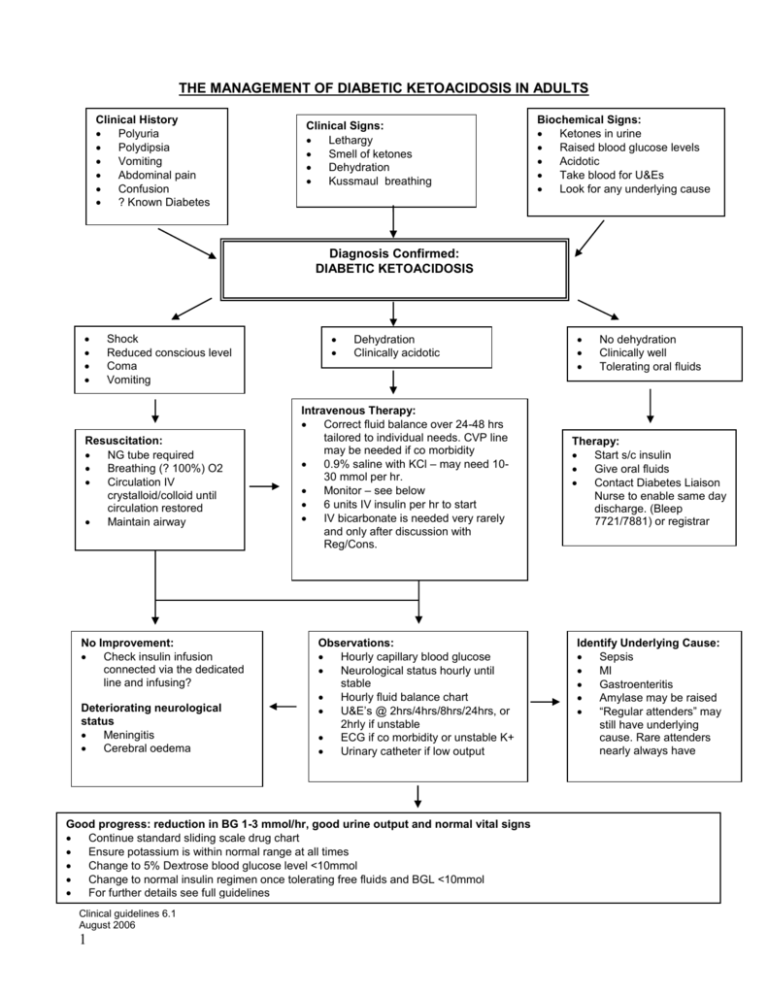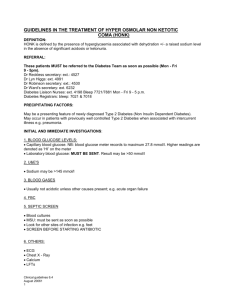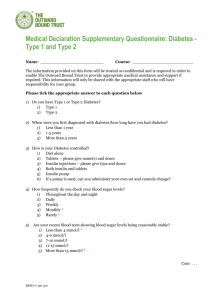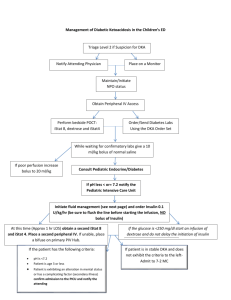guidelines in the treatment of diabetic keto acidosis (dka)
advertisement

THE MANAGEMENT OF DIABETIC KETOACIDOSIS IN ADULTS Clinical History Polyuria Polydipsia Vomiting Abdominal pain Confusion ? Known Diabetes Clinical Signs: Lethargy Smell of ketones Dehydration Kussmaul breathing Biochemical Signs: Ketones in urine Raised blood glucose levels Acidotic Take blood for U&Es Look for any underlying cause Diagnosis Confirmed: DIABETIC KETOACIDOSIS Shock Reduced conscious level Coma Vomiting Resuscitation: NG tube required Breathing (? 100%) O2 Circulation IV crystalloid/colloid until circulation restored Maintain airway No Improvement: Check insulin infusion connected via the dedicated line and infusing? Deteriorating neurological status Meningitis Cerebral oedema Dehydration Clinically acidotic Intravenous Therapy: Correct fluid balance over 24-48 hrs tailored to individual needs. CVP line may be needed if co morbidity 0.9% saline with KCl – may need 1030 mmol per hr. Monitor – see below 6 units IV insulin per hr to start IV bicarbonate is needed very rarely and only after discussion with Reg/Cons. Observations: Hourly capillary blood glucose Neurological status hourly until stable Hourly fluid balance chart U&E’s @ 2hrs/4hrs/8hrs/24hrs, or 2hrly if unstable ECG if co morbidity or unstable K+ Urinary catheter if low output Good progress: reduction in BG 1-3 mmol/hr, good urine output and normal vital signs Continue standard sliding scale drug chart Ensure potassium is within normal range at all times Change to 5% Dextrose blood glucose level <10mmol Change to normal insulin regimen once tolerating free fluids and BGL <10mmol For further details see full guidelines Clinical guidelines 6.1 August 2006 1 No dehydration Clinically well Tolerating oral fluids Therapy: Start s/c insulin Give oral fluids Contact Diabetes Liaison Nurse to enable same day discharge. (Bleep 7721/7881) or registrar Identify Underlying Cause: Sepsis MI Gastroenteritis Amylase may be raised “Regular attenders” may still have underlying cause. Rare attenders nearly always have GUIDELINES IN THE TREATMENT OF DIABETIC KETO ACIDOSIS (DKA) DEFINITION: DKA is defined by the presence of ketonuria and acidosis, not the level of hyperglycaemia. FOR HYPER OSMOLAR NON-KETOTIC COMA PLEASE SEE APPROPRIATE GUIDELINES WHEN TO ADMIT TO HOSPITAL: Patients with newly diagnosed Type 1 Diabetes (Insulin Dependent Diabetes) with ‘mild’ ketosis (not vomiting) and hyperglycaemia seldom need hospital admission. However these patients should be referred to the Diabetes Team, RUH that day. Dr Reckless secretary: ext: 4527 Dr Higgs secretary: ext.: 4991 Dr Robinson secretary: ext: 4530 Dr Ward secretary: ext 6232 Registrar Bleep: 7021 Registrar Bleep: 7018 Diabetes Nurses: MON - FRI: EXT 4198 or BLEEP 7721/7881 OUT OF HOURS: ON CALL MEDICAL TEAM Dr Reckless, Dr Higgs, Dr Robinson and Dr Ward can be contacted via switchboard. Hospital admission is indicated if the patient is acutely ill (e.g. vomiting, dehydrated), very young or elderly. These MUST be referred to the diabetes team as soon as possible. Pregnant women MUST be referred immediately. PRECIPITATING FACTORS: May include infection (overt), or failure to administer adequate amounts of insulin, but also intercurrent illness such as CVA, myocardial infarction etc. INITIAL INVESTIGATIONS: 1. BLOOD GLUCOSE LEVELS: Capillary blood glucose. NB, Blood glucose meters records to maximum 27.8 mmol/l. Higher readings are denoted as ‘HI’ on the meter. Laboratory blood glucose: MUST BE SENT 2. URINALYSIS: ALL SAMPLES MUST BE TESTED FOR KETONES, PROTEIN AND BLOOD 3. ARTERIAL BLOOD GASES: pO2, pCO2, pH OR 4. VENOUS BICARBONATE: BOTTLES MUST BE FULL AND SEALED 5. U & Es: including creatinine 6. SEPTIC SCREEN: blood cultures MSU: Must be sent as soon as possible look for other sites of infection; especially feet SCREEN BEFORE STARTING ANTIBIOTICS Clinical guidelines 6.1 August 2006 2 7. OTHERS: FBC - may be delayed until laboratory working hours ECG - where clinically indicated Cardiac enzymes - where clinically indicated. Chest X - RAY - where clinically indicated TREATMENT: In patients with depressed consciousness (Glasgow coma scale < 14) airways protection is vital as there is a high risk of aspiration. A naso gastric tube should also be inserted. PATIENTS WILL REQUIRE INTENSIVE MONITORING AND MANY WILL NEED TO BE ADMITTED TO HDU OR ITU INSULIN INFUSION: Prepare as 1 unit per ml in 0.9% sodium chloride (e.g., 50 mls Actrapid in 50 mls N/saline) Administer by continuous IV via a syringe driver according to the scale below. It is acceptable to use human insulin in patients who usually use animal insulin. ADMINISTER INSULIN INFUSION AT 6U/HR As long as subsequent measurements are improving, keep insulin infusion rate at 6u/hr. There is no benefit from speeding up the rate. If blood glucose shows no improvement - check infusion pump is working correctly! If blood glucose shows no improvement and pump is satisfactory - increase infusion rate to 8u/hr. If there is still no improvement, increase to 12u/hr. If more than 12u/hr is needed, further increments should be by 6 u/hr. This MUST be discussed with Diabetes Team or on call medical registrar. FLUID REPLACEMENT: Adequate IV fluid replacement is vital - most patients are fluid depleted by 5 litres or more. A typical regime would be: Quantity of Fluid 1.5 litres in first hour 1.0 litre in next 2 hours 1.0 litre in next 3 hours 1.0 litre in next 4 hours 1.0 litre in next 8 hours Type of Fluid 0.9% saline 0.9% saline 0.9% saline 0.9% saline 5% dextrose NORMAL SALINE CAN BE GIVEN IN SUPPLEMENT TO MAINTAIN FLUID INPUT IF NEED FOR IV DEXTROSE > 24 HOURS IF PATIENT HAS A CARDIOVASCULAR HISTORY AND/OR IS ELDERLY (>65 YRS OLD) A CVP LINE AND URINARY CATHETER IS MANDATORY. AFTER THE FIRST HOUR OF FLUIDS PLEASE INFUSE ALL FLUIDS VIA A PUMP Clinical guidelines 6.1 August 2006 3 If acidosis persists consider using 10% Dextrose i.e. Bicarbonate <15 and failing to rise on subsequent tests. Consider using 0.45% sodium chloride if serum sodium above 155 mmol/l and not falling. This should be discussed with the Diabetes Team or on call medical registrar. POTASSIUM SUPPLEMENTS: Await initial electrolyte results, but give 20mmol per hour after first 500mls of IV fluid and adjust dose according to subsequent serum levels. Omit if serum potassium > 6 mmol/l If serum potassium <3.5 mmol/l give 40mmol/hr for 2 hours with repeat U&Es. Repeat as necessary SODIUM BICARBONATE: Not recommended unless pH <6.9 and venous bicarbonate <9 and failing to improve despite other interventions. Then give 50 mls of 1.45% sodium bicarbonate and repeat blood gases/bicarbonate. If acidosis still fails to improve repeat the above and discuss with Diabetes Team or on call medical registrar. ONCE BLOOD GLUCOSE LEVELS <10 MMOL/L USING ADULT INTRAVENOUS INSULIN INFUSION PRESCRIPTION CHART CHANGE TO: Blood Glucose mmol/l Insulin units/hr Additional Infusion Fluids <4 (recheck in 30 mins) 0 5% Dextrose 4.1-6.5 1 5% Dextrose 6.6 – 8.9 2 5% Dextrose 9.0 – 11 4 5% Dextrose 11.1 – 17 6 0.9% Saline 17.1 – 28 6 0.9% Saline >28 (notify doctor) 6 0.9% Saline Additional Action Alert Doctor if unwell or drowsy alert doctor if BGL >11after second reading GIVE FLUIDS 8 HOURLY UNLESS OTHERWISE INDICATED ANTIBIOTICS: Give routinely - e.g. IV Cefuroxime - occult infections are often common precipitants in DKA. ANTICOAGULANTS: Consider heparinisation for patients with severe dehydration Clinical guidelines 6.1 August 2006 4 MONITORING THE TREATMENT OF DKA BLOOD GLUCOSE MONITORING (BEDSIDE): Hourly until stabilised (usually 12 hours after admission) then reduce to 2 hourly. The optimum range is 4 - 9 mmol/l SERUM: potassium } glucose } 2, 4, 8*... 24 hours then as clinically indicated sodium } bicarbonate } if bicarbonate < 20 perform test 4 hourly until level normal BLOOD GASES: Perform blood gas initially then follow up with serum bicarbonate unless pH <7 CARDIAC MONITORING: Indicated in the following situations: Patients > 45 years old. Hypertensive patients Patients where critical fluid balance monitoring is needed (e.g. elderly/cardiac failure) Abnormal ECG A FLUID BALANCE CHART MUST BE MAINTAINED RESOLUTION: Resume diet as soon as patient is able. If patient is newly diagnosed with Type 1Diabetes and Diabetes Team not available then start patient on Human Mixtard 30 ge: 10 units before breakfast and evening meal. Resume sub cut insulin regimen as soon as the patient can eat - give insulin 20 - 30 mins before meal and stop IV insulin 30 minutes after the meal. If patient is on a BD regimen or starting patient on a BD regimen and insulin infusion is to be stopped before lunchtime, give Actrapid 6u 30 minutes before lunch and stop IV insulin 30 minutes after lunch. Commence BD regime with evening meal. Ensure ALL patients with DKA are referred to the diabetes team as soon as possible. Refer patients to the Diabetes Liaison Nurse and Dietitian. Clinical guidelines 6.1 August 2006 5








